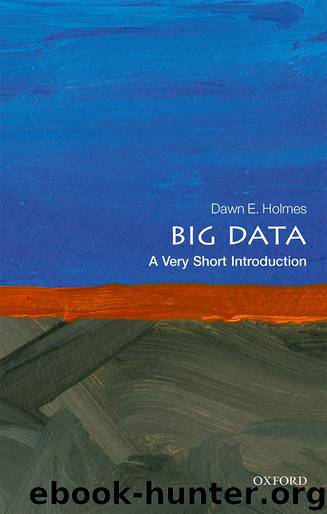Big Data by Dawn E. Holmes

Author:Dawn E. Holmes
Language: eng
Format: epub
Publisher: Oxford University Press
Published: 2017-08-10T04:00:00+00:00
Chapter 5
Big data and medicine
Big data analysis is significantly changing the world of healthcare. Its potential has yet to be fully realized but includes medical diagnosis, epidemic prediction, gauging the public response to government health warnings, and the reduction in costs associated with healthcare systems. Let’s start by looking at what is now termed healthcare informatics.
Healthcare informatics
Medical big data is collected, stored, and analysed using the general techniques described in previous chapters. Broadly speaking, healthcare informatics and its many sub-disciplines, such as clinical informatics and bio-informatics, use big data to provide improved patient care and reduce costs. Consider the definition criteria for big data (discussed in Chapter 2)—volume, variety, velocity, and veracity—and how they apply to medical data. Volume and velocity are satisfied, for example, when public-health-related data is collected through social networking sites for epidemic tracking; variety is satisfied since patient records are stored in text format, both structured and unstructured, and sensor data such as that provide by MRIs is also collected; veracity is fundamental to medical applications and considerable care is taken to eliminate inaccurate data.
Social media is a potentially valuable source of medically related information through data collection from sites such as Facebook, Twitter, various blogs, message boards, and Internet searches. Message boards focused on specific healthcare issues are abundant, providing a wealth of unstructured data. Posts on both Facebook and Twitter have been mined, using classification techniques similar to those described in Chapter 4, to monitor experience of unpleasant reactions to medications and supply healthcare professionals with worthwhile information regarding drug interactions and drug abuse. Mining social media data for public-health-related research is now a recognized practice within the academic community.
Designated social networking sites for medical professionals, such as Sermo Intelligence, a worldwide medical network and self-proclaimed ‘largest global healthcare data collection company’, provide healthcare personnel with instant crowdsourcing benefits from interaction with their peers. Online medical advice sites are becoming increasingly popular and generate yet more information. But, although not publicly accessible, perhaps the most important source is the vast collection of Electronic Health Records. These records, usually referred to simply by their initials, EHR, provide an electronic version of a patient’s full medical history, including diagnoses, medications prescribed, medical images such as X-rays, and all other relevant information collected over time, thus constructing a ‘virtual patient’—a concept we will look at later in this chapter. As well as using big data to improve patient care and cut costs, by pooling the information generated from a variety of online sources it becomes possible to think in terms of predicting the course of emerging epidemics.
Download
This site does not store any files on its server. We only index and link to content provided by other sites. Please contact the content providers to delete copyright contents if any and email us, we'll remove relevant links or contents immediately.
Algorithms of the Intelligent Web by Haralambos Marmanis;Dmitry Babenko(16236)
Jquery UI in Action : Master the concepts Of Jquery UI: A Step By Step Approach by ANMOL GOYAL(9389)
Test-Driven Development with Java by Alan Mellor(7737)
Data Augmentation with Python by Duc Haba(7610)
Principles of Data Fabric by Sonia Mezzetta(7380)
Learn Blender Simulations the Right Way by Stephen Pearson(7296)
Microservices with Spring Boot 3 and Spring Cloud by Magnus Larsson(7139)
Hadoop in Practice by Alex Holmes(6589)
RPA Solution Architect's Handbook by Sachin Sahgal(6519)
The Infinite Retina by Robert Scoble Irena Cronin(6217)
Big Data Analysis with Python by Ivan Marin(5937)
Life 3.0: Being Human in the Age of Artificial Intelligence by Tegmark Max(5518)
Pretrain Vision and Large Language Models in Python by Emily Webber(4896)
Infrastructure as Code for Beginners by Russ McKendrick(4654)
Functional Programming in JavaScript by Mantyla Dan(4438)
WordPress Plugin Development Cookbook by Yannick Lefebvre(4384)
The Age of Surveillance Capitalism by Shoshana Zuboff(4250)
Embracing Microservices Design by Ovais Mehboob Ahmed Khan Nabil Siddiqui and Timothy Oleson(4149)
Applied Machine Learning for Healthcare and Life Sciences Using AWS by Ujjwal Ratan(4136)
